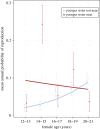Evolutionary significance of maternal kinship in a long-lived mammal
- PMID: 31303162
- PMCID: PMC6664136
- DOI: 10.1098/rstb.2018.0067
Evolutionary significance of maternal kinship in a long-lived mammal
Abstract
Preferential treatment of kin is widespread across social species and is considered a central prerequisite to the evolution of cooperation through kin selection. Though it is well known that, among most social mammals, females will remain within their natal group and often bias social behaviour towards female maternal kin, less is known about the fitness consequences of these relationships. We test the fitness benefits of living with maternal sisters, measured by age-specific female reproduction, using an unusually large database of a semi-captive Asian elephant ( Elephas maximus) population. This study system is particularly valuable to an exploration of reproductive trends in a long-lived mammal, because it includes life-history data that span multiple generations, enabling a study of the effects of kinship across a female's lifespan. We find that living near a sister significantly increased the likelihood of annual reproduction among young female elephants, and this effect was strongest when living near a sister 0-5 years younger. Our results show that fitness benefits gained from relationships with kin are age-specific, establish the basis necessary for the formation and maintenance of close social relationships with female kin, and highlight the adaptive importance of matriliny in a long-lived mammal. This article is part of the theme issue 'The evolution of female-biased kinship in humans and other mammals'.
Keywords: Asian elephant; fertility; kinship; matriliny.
Conflict of interest statement
The authors declare no competing financial interests.
Figures


Similar articles
-
The evolution of female-biased kinship in humans and other mammals.Philos Trans R Soc Lond B Biol Sci. 2019 Sep 2;374(1780):20190007. doi: 10.1098/rstb.2019.0007. Epub 2019 Jul 15. Philos Trans R Soc Lond B Biol Sci. 2019. PMID: 31303170 Free PMC article.
-
How can non-human primates inform evolutionary perspectives on female-biased kinship in humans?Philos Trans R Soc Lond B Biol Sci. 2019 Sep 2;374(1780):20180074. doi: 10.1098/rstb.2018.0074. Epub 2019 Jul 15. Philos Trans R Soc Lond B Biol Sci. 2019. PMID: 31303156 Free PMC article. Review.
-
Early reproductive investment, senescence and lifetime reproductive success in female Asian elephants.J Evol Biol. 2014 Apr;27(4):772-83. doi: 10.1111/jeb.12350. Epub 2014 Mar 3. J Evol Biol. 2014. PMID: 24580655 Free PMC article.
-
Maternal age at birth shapes offspring life-history trajectory across generations in long-lived Asian elephants.J Anim Ecol. 2020 Apr;89(4):996-1007. doi: 10.1111/1365-2656.13049. Epub 2019 Jul 15. J Anim Ecol. 2020. PMID: 31222736
-
Chemical signals in the reproduction of Asian (Elephas maximus) and African (Loxodonta africana) elephants.Anim Reprod Sci. 1998 Oct;53(1-4):19-34. doi: 10.1016/s0378-4320(98)00124-9. Anim Reprod Sci. 1998. PMID: 9835364 Review.
Cited by
-
The evolution of female-biased kinship in humans and other mammals.Philos Trans R Soc Lond B Biol Sci. 2019 Sep 2;374(1780):20190007. doi: 10.1098/rstb.2019.0007. Epub 2019 Jul 15. Philos Trans R Soc Lond B Biol Sci. 2019. PMID: 31303170 Free PMC article.
-
Milk Composition of Asian Elephants (Elephas maximus) in a Natural Environment in Myanmar during Late Lactation.Animals (Basel). 2020 Apr 22;10(4):725. doi: 10.3390/ani10040725. Animals (Basel). 2020. PMID: 32331387 Free PMC article.
-
Infant attraction: why social bridging matters for female leadership in Tibetan macaques.Curr Zool. 2020 Dec;66(6):635-642. doi: 10.1093/cz/zoaa026. Epub 2020 Jun 13. Curr Zool. 2020. PMID: 33391362 Free PMC article.
-
Virtual Fence Responses Are Socially Facilitated in Beef Cattle.Front Vet Sci. 2020 Sep 30;7:543158. doi: 10.3389/fvets.2020.543158. eCollection 2020. Front Vet Sci. 2020. PMID: 33195516 Free PMC article.
-
Evaluating the Reliability of Non-Specialist Observers in the Behavioural Assessment of Semi-Captive Asian Elephant Welfare.Animals (Basel). 2020 Jan 18;10(1):167. doi: 10.3390/ani10010167. Animals (Basel). 2020. PMID: 31963758 Free PMC article.
References
-
- Smith JE. 2014. Hamilton's legacy: kinship, cooperation and social tolerance in mammalian groups. Anim. Behav. 92, 291–304. (10.1016/j.anbehav.2014.02.029) - DOI
-
- Silk JB. 2014. Evolutionary perspectives on the links between close social bonds, health, and fitness. In Sociality, hierarchy, health: comparative biodemography: a collection of papers (ed. M Weinstein, MA Lane), §6. Washington, DC: National Academies Press. - PubMed
Publication types
MeSH terms
Associated data
LinkOut - more resources
Full Text Sources

